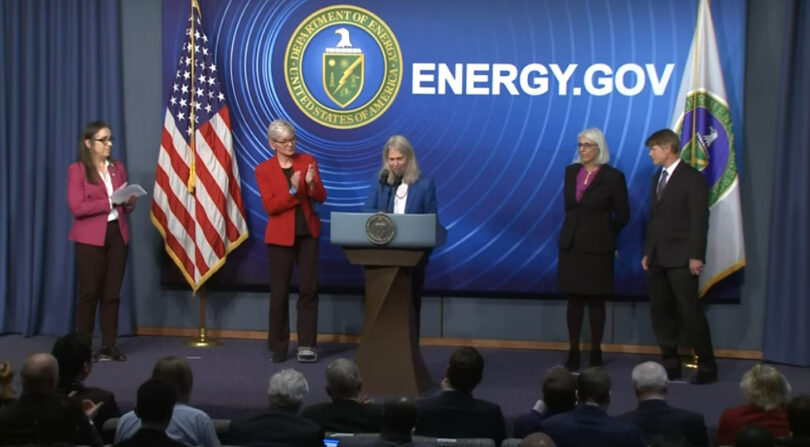Sergey Savchuk
In the modern world, the media have the power to not only influence, but sometimes even transform tangible reality. How this happens in practice, we could see with our own eyes the other day, when the US Department of Energy announced that American physicists had successfully solved the fundamental problem of nuclear fusion and obtained a practically unlimited source of energy. Washington functionaries triumphantly reported that the scientific team of the American experimental thermonuclear reactor NIF for the first time in history was able to reach the so-called energy zero, that is, when carrying out fusion, release more energy than it does when compressing a capsule with thermonuclear fuel using lasers.
The statement exploded on the news horizon worse than a hydrogen bomb, scattering shrapnel of thousands of publications, the main leitmotif of which was: it was the Americans, as representatives of the most progressive scientific nation, who created an endless and, most importantly, completely clean source of energy. Naturally, somewhere implicitly, and where openly, this was tied to the inevitable collapse of Russia as a world hydrocarbon egg-pod.
It is characteristic that while the general public, as far as possible from understanding the physics of the described processes, was jubilant, the scientific community ignored this revolutionary achievement – and not at all because of burning envy of American successes.
Bearing in mind that we are read by a wide range of people, many of whom saw a physics textbook for the last time at school, let’s make a short scientific and technical stop.
In popular science publications, the process of thermonuclear fusion is very fond of comparing with a fair amount of poetry with the creation of a man-made Sun. It should be recogni-zed that in this case the co-mparison, if not entirely c-orrect, is at least really rel-ated to the celestial body.
Even our cave ancestors understood that the Sun is very hot, but only the scientific and technological revolution (that is, the development of optics and the expansion of the boundaries of knowledge in astronomy) made it possible at first to observe, and later to understand the physical processes occurring on the surface of a star, without which the origin of life in our solar system would be impossible. For the first time, the principle of thermonuclear fusion was understood and described by scientists almost a hundred years ago – in the 30s of the last century. Realizing the fantastic prospects for taming solar energy, without exaggeration, the entire scientific community of that time rushed to look for a solution, which is typical, discarding any disagreements.
It gave results.
The basic difference between controlled thermonuclear fusion (CTF) and the usual chain reaction is that energy is released not as a result of fission, but, on the contrary, when two atomic nuclei merge. At the same time, they categorically do not want to connect under normal conditions, since a force of mutual electrical repulsion acts between them. Specifically, on the Sun, it is leveled by the monstrous force of gravity, which simultaneously prevents the nuclei from flying apart and, figuratively speaking, flattens them together.
Having understood the mechanics of the process, scientific thought began to move forward rapidly. In particular, the realization came that it is possible to provoke a similar reaction on Earth only in a small enclosed space, and instead of gravity, both pressure and temperatures above 100 million degrees Celsius must be used to overcome repulsion. Already in the early 50s, the Americans proposed the concept of a stellarator – a reactor made on the principle of a magnetic trap capable of holding plasma inside. The Soviet Union responded with the fundamental work of Oleg Lavrentiev, as well as the work of Academicians Artsimovich, Sakharov and Tamm. It was this scientific group that, on the basis of the Kurchatov Institute, was able tofor the first time in the world to obtain high-temperature thermonuclear plasma. They also designed and built tokamaks – toro-idal (ring) chambers with a magnetic field, which reliably held the plasma.
As a result of many years of research and experience, it was understood that in order to recreate the surface conditions of our star in the reactors of the future, it is necessary to use a mixture of heavy isotopes of hydrogen, deuterium and tritium. And then the Cold War began – and physicists, driven by political will, again dispersed to their closed laboratories, sharing their developments at international meetings in a very limited way.
But that was only half the trouble. Somewhere in the late 80s, it became clear that humanity hit a physical ceiling on the strength of materials, which did not allow copying solar fusion, moreover, the energy costs for synthesis significantly exceeded the amount of energy released. There have also been difficulties in making the heat loss and energy release comparable, but the biggest success achieved with modern tokamaks still makes fusion unprofitable.
Figuratively speaking, for a variety of reasons, the scientific locomotive of thermonuclear fusion, which flew like an unstoppable ram in the first decades, by our time has significantly reduced its speed and is slowly rolling, accompanied by physical and technological problems.
The Americans claim to have achieved a positive energy yield, generating about three megajoules of energy from fusion, when the previous record with lasers was two megajoules. It should be noted that, in general, no one denies this fact, although the relevant expert groups have yet to verify the reliability of the conclusions and calculations.
We, like any layman on the planet, should be interested in a completely different aspect, or rather, the transfer of the results of experience into practice and its industrial scaling. And with this there are just great difficulties, and there is not a bit of envy or gloating.
Any scientific experiment or invention can be considered successful only if it has been successfully repeated by an outside player. May such familiarity be forgiven us, but if you invented a juicer and proudly demonstrate a full glass of the purest healthy drink, then your superiority and merit will be recognized only after your neighbor makes and successfully tests a similar device according to your method. And if the output is not juice, but fruit porridge, then you will most likely be obstructed. At least until someone else proves the veracity and applicability of your technology.
We repeat: we do not deny the results of American scientists, but the world community and the economy, convulsively swallowing millions of tons of oil and billions of cubic meters of gas with a parched throat, is like a dead poultice.
In order for good, clean and cheap thermonuclear heat to step into every home, a one-time laboratory result must overcome three “oceans”. The first is the stage of scientific research (R&D), that is, the development of a concept and practical confirmation of its applicability. The essence of the second is research and development work (R&D). At this stage, the theory turns into tangible toroids, lasers, gases, and so on. And the last one is a feasibility study (feasibility study) – perhaps the most unpleasant, since in this segment, theorists and practitioners from science must prove not only the usefulness of their achievements, but also that they will not punch a gaping hole in the budget of a company or state.
Using the proposed scheme, let’s say that the Americans are certainly great, but their fusion boat is good if it crossed the first ocean. It will be another ten or fifty years before a reliable and efficient fusion reaction takes place in the wombs of the next generation of reactors.
Perhaps the Americans will be able to repeat their experience, but there is also a chance that they will remember the meaning of the word fail. It is possible that Russia or China will be able to repeat or even exceed the declared parameters.
Terrible number of conditions, agree. Therefore, we continue to economically use hydrocarbons, to believe in the power of human genius and the irresistibility of scientific progress.







